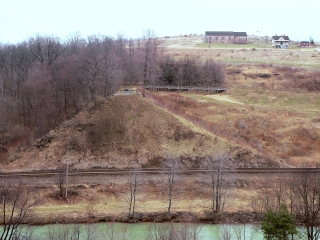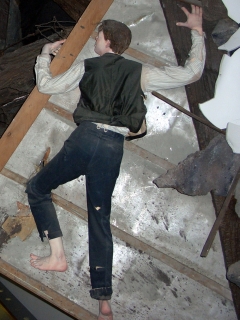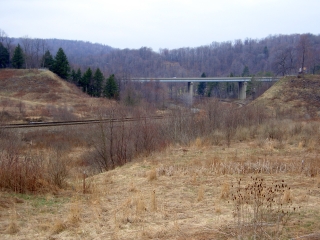NPS Website; Local Website
 WHAT IS IT?
WHAT IS IT?Site memorializing the victims of the May 31, 1889 flood that killed over 2,000 Johnstown, Pa. residents.
BEAUTY (3/10)
The Park Site vistas overlook what was once Lake Conemaugh and is now (again, post-broken dam), just the Conemaugh River. The former South Fork Dam remains, its center remains torn through, powerful visceral evidence of that fateful 1889 day.
The whole panorama still screams of tragedy, aided by the Site’s horror-filled style of education. The western Pennsylvania hillsides, bared by strip-mines and deforestation do not make the situation cheerier. But it is only when you drive the 10-mile steady downhill slope towards center city Johnstown that the sickening ambiance of the flood’s menace fully seeps in.
HISTORICAL INTEREST (4/10)
For years, residents fear a poorly built water control system, so much so that the city’s possible destruction by flood becomes a running joke. Destruction of the environment is so wide spread that the land’s natural protections are gone. During the rainy season, floods are so common that the citizenry becomes lackadaisical about the waters’ power. In said year of heavy rain, mild floods occur but the people refuse to believe that the shoddily constructed dam will break.
10 inches of rain fall in one 24-hour period and the dam does break. Thousands die in apocalypse-level destruction while the rich are spared because they live on the high ground. Post-flood examinations reveal that the wealthy knew of the impending dangers, were warned numerous times of the eventual danger and did nothing. Sound familiar? Well, this “natural disaster” occurred in Johnstown, Pa. in May of 1889.
The broken dam had held back Lake Conemaugh, a recreational lake used solely by the South Fork Fishing and Hunting Club, whose members included the Gilded Age luminaries Henry Frick, Andrew Carnegie and Andrew Mellon. Did the Johnstown Flood affect any change in national opinion or policy change towards this era of unabashed ecological damage and lawless capitalism? Nope.
Capitalist Reform would soon come, but the Great Flood was not a causal factor; it was just a horrible disaster that claimed too many lives.
 CROWDS (5/10)
CROWDS (5/10)The good-sized crowds touring the Park were all a little shell-shocked from the dour heaviness of the Site’s message. Ashen faces, no eye contact and a funereal-esque pall.
EASE OF USE/ACCESS (3/5)
The Memorial is located about 12 miles east of downtown Johnstown, near the town of South Fork and just off U.S. Route 219. Clear signage from U.S. 219 will point you towards the Site.
From the west, the Site is about 30 miles north of the Pennsylvania Turnpike Exit 110 (Somerset) straight up U.S. Route 219. From the east, and Turnpike Exit 146 (Bedford) the Site is a more circuitous 45 miles via I-99 to Pa. Route 52 to U.S. Route 99.
CONCESSIONS/BOOKSTORE (3/5)
A modest selection of books, including about a dozen specific to the flood itself.
COSTS (3/5)
Entry is $4 per person, free with the National Parks Pass. Your admission also covers entry into three nearby NPS sites: the Allegheny Portage NHS, Fort Necessity NB and Friendship Hill NHS.
Entry to the see the unaffiliated Johnstown Flood Museum, located in downtown Johnstown, runs $6 per person.
RANGER/GUIDE TO TOURIST RATIO (3/5)
We spent a nice time with a volunteer eager to point out all the relevant Great Flood-event locations on the horizons. Our numerous questions to the on-duty Ranger, however, were met with lackadaisical disdain. So we just moved on.
TOURS/CLASSES (3/10)
The door into the Site’s theater warns that some of the film’s images may be unsuitable to children. They are not kidding.
The 35-minute Black Friday is a disconcerting black-and-white film, categorized better as a horror film than an educational historic documentary. The film begins with still shots of unmarked gravestones and ends with an image of a maniacal grim reaper and the audible reading (by the death-obsessed narrator, no less) of the list of the victims and the horrific way in which their bodies were found.
What is in between are non-stop grainy pseudo footage of floodwaters, screaming children, collapsing houses, burning buildings and lots of tombstones. It is all a little much.
We were hoping for more background on the natural destruction that caused the flood, something about the effect the flood had on our country as a whole, and just a tad bit of commentary on the cleanup effort and rebuilding of the town; no such luck with either the film or the exhibits. We later learned, through independent reading, that Clara Barton’s efforts during the Flood’s cleanup were the touchstone event that brought the American Red Cross into our national consciousness.
Perhaps the independently run Johnstown Flood Museum with its 1989 Academy Award winning film for Short Form Documentary does a better job. However, after Black Friday, we were in no mood to continue our learning. At the NPS Site, the education is entirely visceral.
 FUN (2/10)
FUN (2/10)Victim-based museums do not have to be death-obsessed orgies. They can be celebrations of lives well led (like the Oklahoma City NMEM), explanations of regrettable historical circumstances enhanced by the triumphant stories of its victims (Manzanar NHS) or just honorable remembrances (like the nearby Flight 93 NMEM). The Johnstown Flood NMEM is none of those things; instead, it chooses to focus only on the flood’s 45 minutes of annihilation, its immediate pain, madness and devastation.
WOULD WE RECOMMEND? (2/10)
Not unless you are a lustful masochist, eager to find superficial pleasure in an over-the-top rendering of extreme violence and destruction...and happen to be traveling near Johnstown, Pa.
TOTAL 31/80
www.usa-c2c.com
© 2004-06